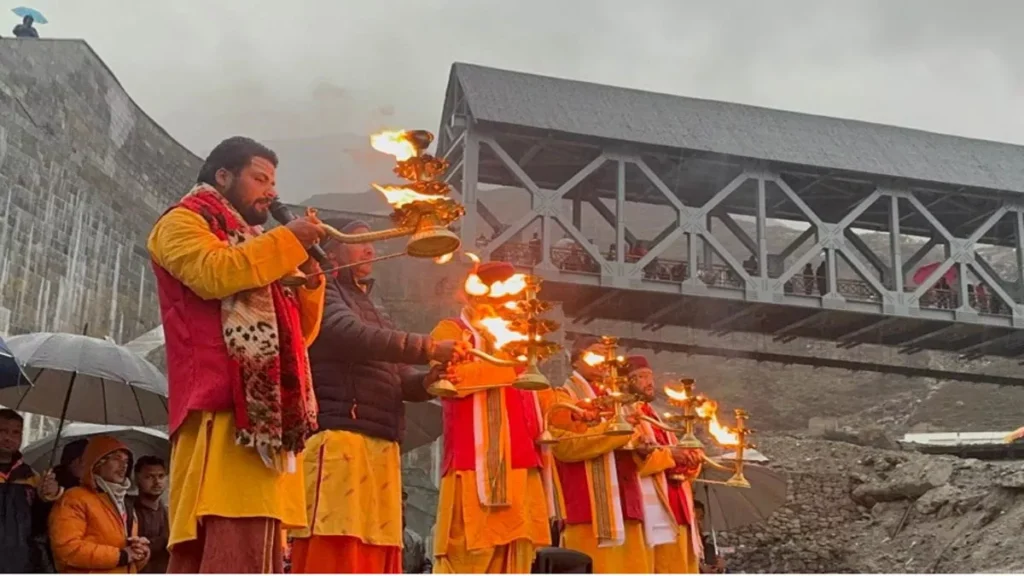
Ganga Aarti Returns to Kedarnath After 12 Years, Rekindling Sacred Traditions
In a powerful spiritual revival, Kedarnath Dham has welcomed back the sacred Ganga Aarti after a 12-year pause. The iconic ceremonies have resumed along the Mandakini River, bringing hope, healing, and divine energy to one of India’s most revered pilgrimage sites.

Quick Read:
- The sacred Ganga Aarti has resumed at Kedarnath Dham after 12 years.
- The rituals were paused following the devastating 2013 floods.
- Daily Maha Abhishek Aarti now takes place at 4:00 AM.
- Shayan Aarti is held at 6:30 PM along the Mandakini River.
- Devotees see this as a spiritual renaissance in one of India’s holiest sites.
After over a decade of silence, the banks of the Mandakini River in Kedarnath have come alive once more with the soulful chants, glowing lamps, and rhythmic bells of the sacred Ganga Aarti. It’s been 12 long years since the last Aarti was performed here, paused due to the catastrophic floods of 2013 that devastated Uttarakhand and left Kedarnath reeling from destruction and loss.
Now, in 2025, the Aarti’s return marks not just the resumption of a ritual—it symbolizes a spiritual rebirth.
A Sacred Comeback
The resumption includes two powerful ceremonies each day. The Maha Abhishek Aarti, held at the break of dawn at 4 AM, purifies the surroundings and begins the day with divine energy. The Shayan Aarti at 6:30 PM brings peace as the day ends, offering prayers and gratitude to the river and the divine.
Performed along the Mandakini River, which flows close to the Kedarnath Temple, these ceremonies are deeply rooted in tradition. Their return holds special significance for pilgrims, priests, and local residents who see this as a sign of resilience and spiritual continuity.
A Long-Awaited Moment
The 2013 Uttarakhand floods had caused unimaginable destruction. The Mandakini River, once a source of spiritual peace, turned turbulent—taking with it lives, homes, and historic sites. The Kedarnath Temple, miraculously untouched, stood surrounded by debris and sorrow. In the aftermath, the Ganga Aarti—an ancient tradition honoring the holy river—was suspended, as the region focused on rebuilding.
Years of reconstruction, coordinated efforts by the state and central government, and the unwavering spirit of the local community have finally brought back normalcy. The reintroduction of the Aarti ceremonies is part of a broader spiritual and cultural revival aimed at restoring Kedarnath’s heritage and significance.
Devotees Rejoice
For devotees, the return of the Ganga Aarti is more than just a ritual. It’s a reminder of faith, of enduring devotion even through tragedy. Many have traveled long distances just to witness the first Aarti after its long hiatus. The sight of oil lamps floating on the Mandakini, the echoing prayers, and the golden hue of the temple in the twilight is a moment of sheer transcendence.
Social media has been buzzing with visuals from the event, and hashtags like #KedarnathAarti and #SpiritualRevival have been trending, showing the cultural and emotional impact of this momentous return.
More Than a Ceremony
While it’s a religious event, the Ganga Aarti also plays a role in eco-awareness. Priests and temple authorities are urging pilgrims to maintain cleanliness, avoid plastic, and participate in eco-conscious rituals. The Aarti now symbolizes both spiritual devotion and a call to protect nature—especially the rivers and mountains of the Himalayas.
Looking Ahead
With more infrastructure improvements underway and spiritual activities returning, Kedarnath is slowly reclaiming its place as a pillar of India’s religious and cultural identity. The return of the Ganga Aarti is not just about resuming a paused tradition—it’s about healing, hope, and moving forward with faith.













Post Comment